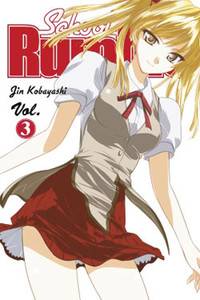Review
by Carl Kimlinger,School Rumble
G.novel 3
| Synopsis: |  |
||
Having been thoroughly ground under the heel of his unrequited love, Harima achieves the blissful state of inner peace that is sought by many but acquired by few. With his newfound connection to nature (complete with ability to speak to animals), Harima begins a new life as a fortune teller and occasional god. But without resolving his dangling "relationship" with Tenma, can he ever truly know peace? And more importantly, can he somehow weasel his way into a summertime trip to the beach with Tenma and her friends? |
|||
| Review: | |||
School Rumble will never be claimed as a shining example of manga (even romantic comedy manga). Anyone who would make such a claim is either confused or an outright liar. As if to hammer the point home, volume three takes the relationship developments of the previous volume and, like any good romantic comedy, nullifies them first chance it gets. Yet, even in the midst of executing this most infuriating of romantic comedy maneuvers, the manga retains its interest by being that rare entertainment beast: a romantic comedy that is actually funny. While all of the attributes of previous volumes are in force this volume—namely the occasional quiet, serious chapter and a peculiar incremental approach to characterization—what carries this volume is the humor. Humor has always been a strong part of the series, but here it comes into its own. Instead of chuckles, this volume is brimming with full-bodied laughs. The heart of this comedy lies in the cast, and the best laughs arise from the unexpected meetings and clashes of their respective quirks, oddities, and obsessions (especially several brutally hilarious mileposts in Harima and Eri's drastically worsening relationship). The mix of gag humor and character building that results keeps the humor from getting too stale and the characterization from being obvious, a true one-two punch. Other laughs are wrought by mocking shopworn shounen comedy staples, usually with a well-timed role reversal (including a most amusing violation of the law of comedy physics that governs the gravitational attraction between a falling boy's face and the object of his affection's rear-end). The comedy is fueled by the manga's fully-automatic pace, and the author's comic timing, both artistic (the riotous consequences of a character's actions are often overleaf from its buildup) and narrative (jokes and events are allowed to fade away, only to resurface at the most cruelly—and hilariously—inopportune moment possible). The other half of the manga's genre categorization (i.e. the "romance" half) isn't ignored, but it is best when inextricably intertwined with the humor. The inherent drama of romance lends weight to the humorous consequences of actions, and any straight drama makes the inevitable outbursts of comedy funnier in comparison. However, the reverse is also true; the humor often lightens the drama, and knowing that serious events will be punctuated by a gag sometimes cripples their ability to elicit emotional responses. Attempts at straight drama provide welcome lulls in the onslaught of gags, but also clearly show the strain of their sustained seriousness. Luckily Kobayashi's pessimistic approach to love is on hand to give both the comedy and the romance extra bite. Every character is in love with a person who not only doesn't return their affections, but is also very obviously wrong for them. While sometimes frustrating (and often confusing, especially once the obligatory misunderstandings begin to proliferate), having virtually every potential relationship doomed to failure (if they ever even manage to begin) casts a bittersweet shadow over the chaotic humor and Byzantine mazes of romantic intersections that lends them both a cutting edge they wouldn't otherwise have achieved. Excepting the addition of some swimsuit fan-service, Kobayashi's art is unchanged since the previous volume: From the sporadic occurrence of remarkable, heavily shadowed and detailed scenes—usually involving Harima (and used to great comic effect during the beach chapters), to the simple, anime-friendly, and mildly generic characters whose distinctiveness owes more to their well-defined personalities than to their varied hairstyles and body-types, to the backgrounds that spend as much time being obscured as they do establishing settings. Panel layouts are resolutely rectangular, and are still a little too busy, a side-effect of the rapid pace of the humor. Kobayashi's habit of placing comments on the sidebars, while informative, is intrusive to the point of distraction. Del Rey continues to do well with the quality of their books. Quality paper, clean artwork, attractive covers, and plentiful cultural notes; it's not perfect, but it is certainly a cut above the norm. Not all of the kinks have been worked out—Kobayashi is still better at being funny than he is at being touching, and zeroing out progress in the primary relationships is as welcome as a Viking at a vegan party—but Kobayashi delivers his jokes with devastating skill, and the cast of cleverly tweaked stereotypes is as likable as ever. And while the web of relationships and misunderstandings does creep ever closer to incomprehensibility, for now it's a battlefield of conflicting desires that is truly deserving of the title School Rumble. |
| Grade: | |||
|
Overall : B
Story : C+
Art : B
+ Very, very funny; intermittently touching. |
|||
| discuss this in the forum (10 posts) | | |||
| Production Info: | ||
|
Full encyclopedia details about Release information about |
||